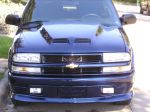Just passing this on for you guys. REDI-COAT can chemically strip pretty much anything (car, chassis, doors, parts, etc.) up to 13'6" then apply PPG epoxy primer electronicly all of this done by using a dipping technique.
I'm thinking about doing this to my notch, to address any rust in those pesky front frame rails. Then I was going to prep and paint it myself.
Click the linky link for more info.
Best - Dave






 Reply With Quote
Reply With Quote





Bookmarks